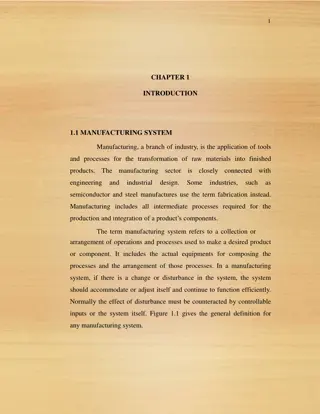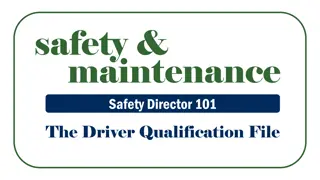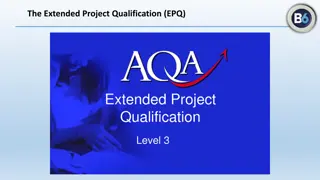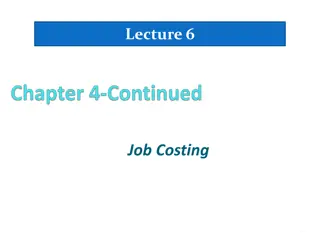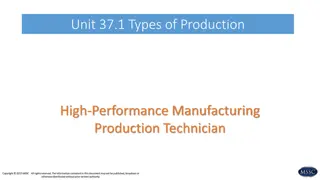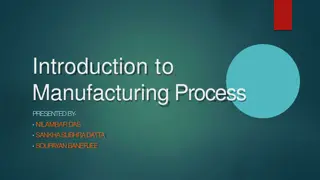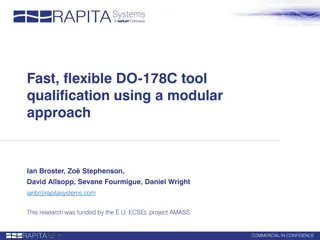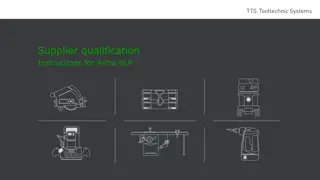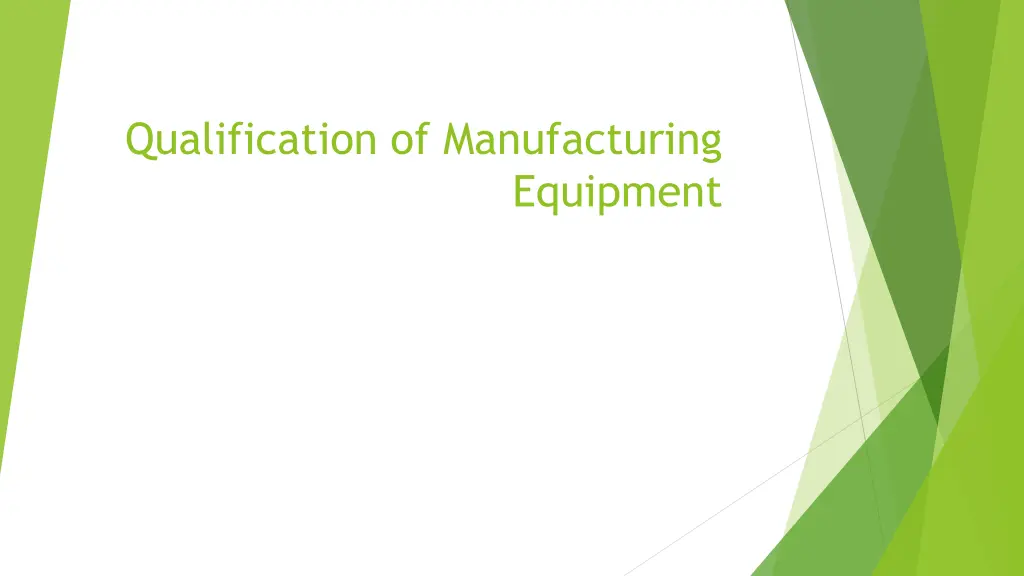
Equipment Qualification in Manufacturing
Ensure the proper functioning of manufacturing equipment through equipment qualification, establishing documented evidence that equipment and processes meet predefined specifications. Discover the importance of equipment validation, the difference between qualification and validation, and the benefits it offers in reducing rejections, improving efficiency, and ensuring product quality throughout the manufacturing process.
Download Presentation

Please find below an Image/Link to download the presentation.
The content on the website is provided AS IS for your information and personal use only. It may not be sold, licensed, or shared on other websites without obtaining consent from the author. If you encounter any issues during the download, it is possible that the publisher has removed the file from their server.
You are allowed to download the files provided on this website for personal or commercial use, subject to the condition that they are used lawfully. All files are the property of their respective owners.
The content on the website is provided AS IS for your information and personal use only. It may not be sold, licensed, or shared on other websites without obtaining consent from the author.
E N D
Presentation Transcript
Qualification of Manufacturing Equipment
Contents Introduction What is equipment qualification ? Difference between qualification and validation Why is it required ? Who should do equipment validation? Types of equipment qualification Different manufacturing equipment used
What is equipment qualification ? Equipment is an collective analytical measurement assembled to perform a mechanical process. Without an equipment we cannot manufacture a product. So, EQ (Equipment qualification) is action of proving that an equipment works correctly and accordingly so as to give the accurate and reliable results. If equipment is validated we can ensure that our product is of best quality. So term validation and qualification are interlinked to each other.
Difference between Qualification and Validation QUALIFICATION VALIDATION Determines whether equipment, system , and process are suitable for their intended purpose. Ensures that processes consistently produce products meeting predetermined quality standards. Focuses on the entire manufacturing process. Focuses on equipment , system and processes.
Establishes documented evidence that equipment/systems perform according to predefined specifications . Provides documented evidence that the entire manufacturing process consistently produces the desired quality product. Carried out throughout the lifecycle of a manufacturing process , from development to routine production. Typically performed during the installation , operational and performance stages of equipment/system lifecycle.
Why is it required ? For reduction in rejections and reworking . For reduction in utility costs . For avoidance of capital expenditures . Fewer complaints about process related failures . Reduced testing in-process and in finished goods . More rapid and reliable start-up of new equipment . Easier maintenance of equipment.
Who should do equipment validation? The vendor or the user has the ultimate responsibility for the accuracy of the analysis results and also for equipment qualification. DQ should always done by the user . While IQ for a small and low cost instrument is usually done by the user ,IQ for large ,complex and high cost instruments should be done by the vendor .
OQ can be done by either the user or the vendor . PQ should always be done by the user because it is very application specific , and the vendor may not be familiar with these . PQ should be done on daily basis .
Types of Equipment Qualifications : A. Design Qualification B. Installation Qualification C. Operational Qualification D. Performance Qualification
A. Design qualification Design qualification (DQ) defines the functional and operational specifications of the instrument and details for the conscious decisions in the selection of the supplier . The steps that should be considered for inclusion in a design qualification : a) Description of the analysis problem. b) Description of the intended use of the equipment. c) Description of the intended environment. d) Preliminary selection of the functional and performance specifications. e) Preliminary selection of the supplier.
e) Preliminary selection of the supplier. f) Final selection of the equipment. g) Final selection of the supplier. h) Development and documentation of final functional and operational specifications.
B. Installation Qualification Installation qualification establishes that the instrument is received as designed and specified , that it is properly installed in the selected environment ,and that this environment is suitable for the operation and use of the instrument. The qualification involves the coordinated efforts of; The vendor . The operating department . The project team.
C. Operational Qualification Operational qualification (OQ) is the process of demonstrating that an instrument will function according to its operational specification in the selected environment. The proper operation is verified by performing the test functions specified in the protocol. A conclusion is drawn regarding the operation of equipment after the test functions are checked and all data has been analyzed .
Following are the contents of equipment operation qualification : Application SOP s Utilization list Process description Test instrument utilized to control test Test instrument calibration Critical parameters Test functions Test function summaries
D. Performance Qualification Performance qualification (PQ) is the process of demonstrating that an instrument consistently performs according to a specification appropriate for its routine use. PQ should always be performed under conditions that are similar to routine sample analysis . PQ should be performed on a daily basis or whenever the equipment is being used . In practice ,PQ can mean system suitability testing , where critical key system performance characteristics are measured and compared with documented.
List of manufacturing equipment used : 1. Dry powder mixers 2. Fluid bed dryer 3. Tablet compression machine 4. Dry heat sterilization 5. Autoclave 6. Capsule filling machine
1. Dry powder mixer Mixing of the API and excipients is the critical step in the solid dosage form preparation that effect the content uniformity to great extent. Dry powder mixers have been used by industries for proper blending and to maintain uniformity in the production batch.
Types of powder blenders : V cone blenders Double cone blenders Ribbon blenders Conical screw mixer Tumble blender
a] Installation qualification : Details of the equipment ; Equipment name ,made by ,and model no. shall be noted down . Location for the installation equipment shall be checked . Any deviations observed while following above procedure should be informed for corrective action . Installation procedure ; After checking all the specifications as mentioned in the selection criteria , service engineer shall verify the equipment . Authorized validation team shall carry out installation checks .
Operational qualification ; After completion of successful installation qualification , initiate the actual operation to ensure that the machine is operating within specifications . Check the operation qualification parameters against their specifications . Document the deviation details. The quality head and the department head shall decide weather deviation is acceptable or not. Performance qualification ; Load the material to be mixed in the mixer. Start the mixer and rotate it for the time as mentioned in the BMR. After completion of mixing switch off the mixer and separate out the drum . Send the samples to quality control department for content uniformity , bulk density and sieve analysis .
Requalification criteria ; Location of the equipment is changed . There is change of parts that have a direct effect on the performance of the equipment .
2. Fluid bed dryer Fluid bed drying is most widely used technique for drying pharmaceutical powders and granulation . The direct contact between particle and air/gas is possible in fluid bed system. Here any type of inert gas or air can be used (for eg ; helium ,neon ,argon, krypton ,xenon ,and radon)
Design qualification ; In fluidized bed dryer the design of the instrument should be: Should occupy small place . Based on our requirement we can go for horizontal or vertical . All the technical consideration should be kept in mind while doing the design. Installation qualification (IQ); Installation qualification for fluidized bed dryer include the following steps: Equipment should comply with the original purchase specifications. Utility installation ,Operating manual Check for any physical damage Verify electrical supply Inlet air installation SOP , Mfg /Supplier details
Operational qualification (OQ) ; Documented verification that the system performs as intended throughout all anticipated operating ranges ,some of them include: Verify alarm control Speed of air Moisture content Tap density Particle size distribution Heat distribution study
Performance qualification (PQ); PQ means to check what we want actually for that particular process from the equipment , what processes are to be monitored : Inlet air speed Quality of air Uniform distribution of air Mixing of air with temperature Run the trial batch during operation and there should not be any change in the; Size Shape Surface characteristics
3. Tablet compression machine A tablet press is a mechanical device that compresses powder into tablets of uniform size and weight . A tablet press can be used to manufacture tablets of a wide variety of materials , including pharmaceuticals , nutraceuticals , cleaning products , industrials pellets and cosmetics.
Installation qualification ; The installation qualification will confirm details: Model number. Serial number . Location of the equipment. The accessories and their spare parts checked as per purchase order . Any deviation observed should be informed to the supplier manufacturer
Operational qualification ; Equipment can operate with specified limits Upper punch test Lower punch test Tablet press speed Tablet press rotation direction Performance qualification ; PQ activities demonstrates and documents that the equipment is able to perform its intended functions. To ensure that the quality and purity of the product is maintained. Record the number of damaged tablets. Tablet should be tested for weight uniformity ,hardness test ,friability, disintegration etc. Tablet batches should be tested for content uniformity.
4 . Dry heat sterilization Dry heat sterilization is a sterilization process that can be used to terminally sterilize health care products , medical devices , equipment , components or bulk active pharmaceutical ingredients exposing the items to a temperature of not more that 160 Celsius for a defined time.
Design qualification; It includes : Facility layout . Decision of batch or continuous process. Utility requirements and specification . Pressure differential requirements . Required capacity of the sterilizer . Type of material to be sterilized . Installation qualification; The IQ protocol verifies and documents that the equipment is installed correctly and meets all the manufacturer and user requirements. During the execution of the IQ protocol ,the equipment drawings , calibration status of critical instruments , instrument and valve information , utility information , and standard operating procedure for the equipment are all confirmed.
Operational qualification; Temperature monitors: The temperature controllers , recorder and sensors on the process equipment must be calibrated before the unit can be operated reliably . Cycle timer : The accuracy of the timer must be determined. Door interlocks : If a unit is equipped with double doors ,the interlocks must operate such that the door leading to the aseptic area cannot be opened . Heaters : All the heating elements must be functional. Cooling coils : To enable a faster cool-down cycle, the air is often circulated across coolant coils . Particulate counts : particulate counts should be checked before and after sterilization . Chamber leaks : The perimeter of the doors for batch sterilizers should be checked for air leakage while operating .
5 . Autoclave An autoclave is a pressure chamber used to carry out industrial processes requiring elevated temperature and pressure different to ambient air pressure . Autoclave are used in medical application to perform sterilization, and in the chemical industry .
Design qualification; Design qualification includes: Facility layout Utility requirements and specifications. Required capacity of the sterilizer. Type of material to be sterilized. Installation qualification; The IQ process is intended to demonstrate that autoclave installed meet all specification installed properly and supporting program are in place. The IQ includes following checks; Supplier or manufacturer name and address shall be checked. Any deviation observed should ne informed to the supplier or manufacturer through purchase department for corrective action.
Equipment name ,model no. shall be noted down. Site specification , construction material , change / spare parts. Operational qualification; The OQ process intended to demonstrate that components of autoclave operate properly and ready for performance or load testing. OQ includes following checks; Operation tests. Leak/air removal test. Power loss recovery test. Several utilities need to be verified. Selection and calibration of thermocouples must be durable for repeated use.
Performance qualification; Performance qualification is documented evidence to prove that equipment / system is performing under specified condition. It involve in taking trial under loaded condition . Heat distribution studies are carried out in two phases: 1. Heat distribution in an empty autoclave chamber. 2. Heat sterilization in a loaded autoclave chamber. The difference in temperature between the coolest spot and the mean chamber temperature should be not greater that 2.5 degree Celsius.
6 . Capsule filling machine A capsule filler is a type of machine used to fill empty capsules with pharmaceutical ingredients. It is a mechanical device that fills the powders into hard and soft gelatin capsules.
Design qualification; A hand operated capsule filler can produce about 800 capsules in one pressing. These capsule filling machine have loading trays that hold a volume of 300 holes. A powder tray is also attached to the machine itself. The pin plate works as a filter of the machine and a sealing plate that seals the cap of capsules. Installation qualification; It has to be ensured that the equipment is been installed as specified by the vendor. Equipment name , made by and model no. The purchase order number and date shall be checked. Supplier or manufacturer name and address shall be checked. Any deviation observed should be informed to the supplier or manufacturer.
Operational qualification; Before initiating the OQ ensure that SOP for operational and cleaning of capsule filling machine is available. Check all the dynamic attributes of the capsule filler conform to the required specifications. The operation of indicator , controls and alarms is verified. Oil leaks that could contaminate the process are observed. Performance qualification; PQ demonstrates and documents that the equipment is able to perform its intended functions within the variable process limits for a specific product. Capsules from throughout the lot should be tested for weight uniformity. Capsules from the end of filling should be tested for blend content uniformity. To ensure that the quality and the purity of the product is maintained.
7. Membrane filtration Unit operation of filtration is the separation of solids from a liquid by passage through a filter medium. Membrane filtration is used for sterilization of drug products and used in sterilization process.
Design qualification; DQ defines the functional and operational specifications of a instrument DQ details the conscious decisions made in the selection of the supplier DQ should ensure that instruments have all the necessary functions and performance criteria that will enable them to meet user requirements The list shows the recommended steps should considered during DQ.
Installation qualification; IQ establishes that the instrument is received as designed and specified , that it is properly installed in the selected environment IQ tell about environment that environment is suitable for the operation and use of the instrument Performance qualification; PQ is the process of demonstrating that an instrument consistently performs according to a specification appropriate to its routine use
PQ should be performed on a daily basis whenever instrument is used The test frequency depends not only on the stability of the equipment but also on everything in the system that may contribute to the analysis results
References Berry I.R., and Nash R.A., "Pharmaceutical Process validation" second revised and expanded; Marcel Dekker series; 83-110. Equipment Qualification & Validation of Autoclave, Dry Heat Sterilization And Membrane Filtration. Manohar A. Potdar "Pharmaceutical Quality Assurance" Nirali Publications, 6th edition, 2017. Sawant R., Hapse S., "Fundamentals of Quality Assurance Techniques" 2nd edition, Career Publications, May 2016.





